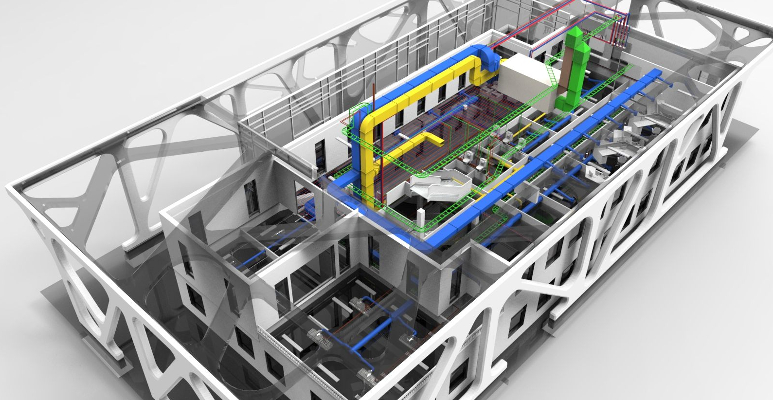Construction projects can run so much more efficiently if information from the various disciplines is well matched, believe Herwin Voortman and Rob Roef, both board members of buildingSMART Netherlands. For this to happen, that information must be exchanged in a standard and open way, and that is possible with the openBIM standards. Among other things, these allow BIM models to be exchanged easily and errors or gaps to be detected quickly and in a standardized manner. This year another major step forward was taken by buildingSMART with a new standard.
'We produce an awful lot of data in construction,' begins Herwin Voortman, 'and you have to manage that well. There are a lot of 3D models and often a multitude of 2D drawings. Then you often have all kinds of versions going around. Before you know it, data gets lost or it no longer all fits together. Processing information well is therefore very important for a project.' The openBIM standards were developed to make that easier.
Open standard for BIM
By applying the openBIM standards developed by buildingSMART International, BIM models can be shared in a standard way. For that sharing, first of all, the IFC standard was developed, says Rob Roef. 'You have a lot of BIM modeling programs that are used by many different professional groups. All those programs speak IFC.'
Using IFC, information is exchanged in an easy and standardized way between different disciplines in construction. In fact, everyone creates and shares IFCs with each other. Moreover, in addition to IFC, further standards have been developed that further facilitate cooperation.
First, there is the BCF standard, which makes communication very clear about issues in the model. Once all IFC files are delivered, they are merged into a 3D coordination model, on which the BIM coordinator performs checks. These checks then show whether the various IFC files for the same project fit together properly and whether there is any conflicting information or gaps. 'This is very much needed,' Roef emphasizes, 'because sometimes dozens to even hundreds of IFCs are created for a building, from which the total 3D model is built. The check shows that, for example, an installation duct has to go through a steel profile. At that spot, the IFCs do not fit together properly, and then it is also clear who has to solve that. These issues are sent in a BCF format to the relevant parties, who therefore know exactly what is wrong. They then deliver new IFCs with the adjustments, which then also have to be checked again.'
'Those steps repeat themselves weekly or biweekly, from the design phase through delivery,' Voortman adds. 'So it's essential that communication is completely clear and transparent. That's why the BCF standard is so important.'
Specific demand
Then there is the openCDE standard, which allows the entire model to be published to the client and thus incorporates all the different IFCs into one big whole. And recently there is a new standard, at the very beginning of the chain: IDS. This allows the client or the main contractor to request standardized items. "Things regularly go wrong there because requests are not specific enough," Voortman points out. "Very simply put, when you ask for a door, you can mean an interior door, an exterior door or even a garage door. You have to be very specific.' IDS helps with that so you don't overlook anything that seems obvious.
IDS is then used to check whether everything is included as requested in IDS. Roef: 'If, for example, it has been requested that doors on a certain floor should have the property 'fire-safe' and it turns out that this has not been included everywhere, then this is immediately detected with BCF. The modeller in question must then deliver a new IFC in which this is solved.'
IDS has been around for a good year now, and since July 1 it has actually been an openBIM standard.
Cost of security
Large construction companies are already aware of the benefits of working with the standards, according to Voortman and Roef. But there is still much room for improvement among SMEs. "If you use openBIM, you can deliver faster, work more efficiently with fewer people," says Roef. "And very important: if everyone speaks the same language, you have fewer failure costs. That really needs to get through to the contractors in SMEs with 15 people in the office.
It's primarily about reducing failure costs, but according to the two buildingSMART board members, it's also about the costs incurred for precisely not failing. Voortman: "Take the company that comes to lay the foundation. That foundation, for example, requires 11 cubic meters of concrete. But if there is just too little in the truck, it has to be driven again and that costs a lot of money. So they only take 11.5 cubic meters just to be sure. That happens with everything. In construction projects, it's serious money being wasted. With IFC you can calculate quantities very accurately, and so you can avoid those costs.'
Porsche into the ditch
'When I come to a company and I say they probably don't have 15 percent failure costs here, everyone at the table starts laughing,' Voortman continues. 'But actually, of course, that's not funny at all. This way you drive a luxury Porsche into the ditch every time. Everyone accepts that about themselves and it is not seen as a problem. It just gets written off on General Expenses.'
That greater efficiency and lower costs are very much needed in construction, Voortman and Roef believe. Because the task is huge. "If you set the high failure costs against the already high construction costs and against all the people who cannot buy a house, then the openBIM standards are part of the solution," says Voortman. 'At least they contribute.'
OpenBIM on DigiBouw
Curious about what your organization can do with openBIM? Join us in November at DigiBouw, where buildingSMART is hosting content sessions on OpenBIM standards and how to apply them.






